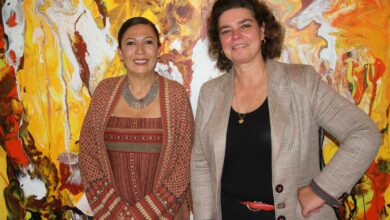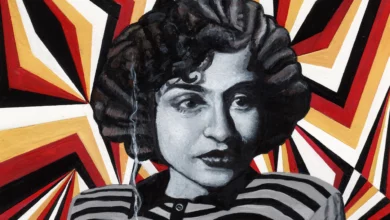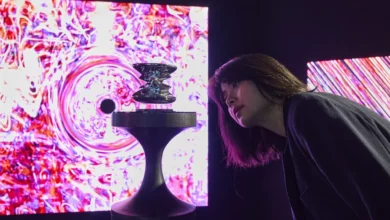On Blue fish, beautiful women and the state of Egyptian modern art
The paintings show beautiful women dressed in white linen, contrasting with their tanned, glorious figures. Blue fish, white eggs, lotus flowers, and hoopoe birds accompany the women, suggesting the grace of ancient Egypt with a contemporary twist. These are the paintings of artist Helmi el-Touni at his latest exhibition “Nefertari and Her Sisters”
"All my life women were my art type," says Helmi el-Touni, explaining that throughout history women were the symbol of beauty. "I depicted Nefertari, which means ‘the most beautiful of beautiful women’ and has one of the most gorgeous tombs in the valley of queens," said el-Toumi of his recent exhibition that features the ancient queen and her sisters in classical and modern representations.
El-Touni says he started this collection by reflecting on the elements of beauty in the pharonic art, starting with the palette. "It is harmonious compilation of earthy colors: shades of brown, green and turquoise and the contrasting terracotta, along with the black curly hair and the white linen. It reflects nature and the life of the people who lived in Upper Egypt and used to wear cool cloth."
Though deviating from the still and side postures of ancient Egyptian art, el-Touni’s work maintains their nobility and grace. "The space is divided geometrically, reflecting the abstract school, yet not quite," notes the artist. Together with the white strokes in the lotus, its three dimensional vase echoing modernity, and the egg, (a vintage Touni motif) create "a visual music piece." This form of visual combinations is what makes el-Touni unique. Since 1987 his work has been dealing with Egyptian folk art.
His most recent exhibition is another step in his attempt to create a visual language that is new, while simultaneously influenced by the ancient. Before 1987,says el-Touni, he was just another Egyptian artist influenced by Western academia. It wasn’t until he returned to his native country after 12 years in Lebanon that el-Touni was able to find his own visual language, especially as he drifted toward printed arts, like book covers and magazines.
El-Touni says he was fascinated by the linear and two-dimensional oriental artwork found in stained glass and free hand drawings in peasants houses and he wanted to go back to those roots, just like Italian and French artists of the fourteenth century went back to their authentic roots. "They formed a new art that was connected with their Greek and Roman roots, yet reflected their modern life," he said. "Hence the Renaissance."
"When I looked, I didn’t find myself either pharonic, Coptic or Greco-roman, or Islamic. I realized that I am an amalgamation of these cultures," says el-Touni. "This is why it took me almost 25 years to reflect this visual folk art vocabulary."
Many discouraged this exploration of folk art themes out of a bourgeois disdain for folk art, which is considered a product of the lower classes. Work of that kind is referred to as "baladi" or local, and taken not to hold up against artistic standards. Nonetheless, el-Touni took a chance on the inherited genes of Egyptian people and his first exhibition adopting the folk art motifs in tattoos. It was a great success.
"Tattoo artists used to walk around during mulids (religious carnivals) and feasts, with a wooden pallet with small glass pictures, each with eight to ten motifs for the customers to choose from," explained el-Touni
This art is rich in symbols that transform the body into a decorated wall. "It also possesses a magical power of the symbol," el-Touni says.
The fish, for example, is a symbol of fertility in folk beliefs, so women who want to bare children wear such tattoo. "We sarcastically mock the stereotype of Upper Egyptians drawing birds on both sides of their forehead, mistaking it as a sign of foolishness," says el-Touni. "On the contrary, one draws such birds in order to imitate their speed, which is a symbol of intelligence and wit.”
There are other symbols, which are drawn to avoid evil, just as the ancient God Sobic, who was half human and half crocodile, was hallowed and granted many sacrifices to prevent his harm.
After becoming interested in this, el-Touni delved into the world of ancient Egyptian motifs. The hoopoe is his personal logo because it is an Egyptian bird that managed to survive such pollution. The egg motif first appeared in el-Touni’s exhibition “A Courtesy to the Coptic Art.”
"I think the egg is the essence of life, the beginning, the seed. It is very fragile, just like life itself," notes el-Touni. The position of the egg however is magical, thus without logic. Yet the egg provides balance to the painting. Without it there would be something missing. The symbol remains a theme that cuts across all of el-Touni’s paintings, a thing that gives them an air of familiarity despite of their diversity. "It’s like you are collecting souvenirs, throughout the years that are gradually reflected in your paintings," he says.
‘Waging two wars’
To el-Touni, given the circumstances in Egypt and the Arab region, the mere creation of art is a form of resistance. "People nowadays believe that art and singing is haram or religiously prohibited," he says, noting that two weeks ago the missionary of el-thaqafa el-gamhiria in Marsa Matrouh was pelted with stones. Fatwas from honorable sheikhs declare drawing as haram. This is why el-Touni believes that practicing this form of art is a resistance to the darkness that is creeping our way.
"I am waging two wars,” he says. “One locally and the other on the Western artist at large who wants me to be a copy of him or else he will not accept me."
“Unlike the resistance in the fifties and the sixties when there was no doubt in our identity,” el-Touni continues. “We knew who we were, but we are lagging behind. Nowadays the question is: Who are you, are you the wahabbi gulf or are you the foreigner?"
"This happened the moment we decided to imitate the other," he says, noting how during the adoption of free market in the 1970s Egypt adopted “free culture” as well. El-Touni doesn’t think this was a necessary change. He cites the example of India, which adopted a free market economy while maintaining its culture and heritage. “It shouldn’t be one package,” he says.
Away from the crowd?
El-Touni admits that these days fine art is far removed from average Egyptians. Since 1908 Egypt has been trying to adopt a form of art that ceased to exist with the Arab invasion of Egypt in the seventh century. The Egyptian style was replaced with verses from the Quran or an imitation of plants and flowers or the arabesque. After this came Mohammed Ali’s attempts to modernize Egypt, at which point Egyptians started to learn modern art, such as painting. Paintings hanging on the wall have nothing to do with the daily rituals of Egyptians. (The exception is some paintings that were called el-moraba’at, square paintings that were bigger than a book but not the illustrations of the book. These were not hung on the walls. They were expensive hence not popular and safely kept in leather folders.)
"So up till now the idea of the wall painting has no roots, though they are found in most homes now. It shows another form of pleasure other than the basic needs of the person. It is a sign of progress," said el-Touni explaining that the role of art is not only to amuse but also to elevate the quality of life. Art, he believes, connects the ordinary citizen with the values of creativity and perfection. Even the art officials do not appreciate this relationship between art and the people.
Since Egyptians are newcomers to this art form, explains el-Touni, we have not lived through development and transitional periods of different phases between the orientalists and the various forms of arts phases that reached the abstract, installation, performance art, art pouvera. "Hence there is alienation between the current citizen and the painting, limiting art appreciation to the simple and sometimes melodramatic effect, because it is emotionally effective or resembles the painting of the foreigner.” (The salon ferme kind of art featuring ballet dancers and women resembling Marie Antoinette, according to el-Touni, exemplifies this imitation of foreign art.)
Consequently there is a gap between the young artists and the average citizens. Most young artists follow modern role models who believe that art should be abstract, says el-Touni, although abstract is only one style of many.
El-Touni also says that the recipients of modern art are not ready for it. In the 1950s, schools offered classes in art appreciation in addition to drawing. "Nowadays they tend to replace art classes with computer ones, though both of them are equally important and cannot replace one another," he says. Average people started to resent all forms of modern arts except a few categories that expands and shrinks depending on the socio-economic status of the country.
On the other hand, some artists have deliberately tried to challenge their audiences in reaction to the status quo. "Since audience neither understand the artists nor their works, some artists disregarded audience, believing themselves to be their superiors," says el-Touni.
On a related note, el-Touni says that painting is not exactly in the limelight of the national media. "Television for example—I am talking regular channels—the average Egyptians do not watch the cultural channels. The regular land channels feature religious programs that demean arts, and there are no art programs except those that are broadcast at 3 AM to make sure that nobody watches," el-Touni argues. "I am one of the very few people concerned with this gap. As artists it is our duty to be concerned with public issues or else we would be traitors, because this country has given us a lot."
Printed art
Books and magazines have always been another venue for el-Touni’s work. In fact, he has won numerous awards for his work, including the Leipzig Book Fair Bronze Medal (1982), first prize of the Children’s Book Prize from the Cairo International Book Fair (1998), first prize in the Suzanne Mubarak Competition for Children’s Literature (1999 and 2000), and the Bologna Ragazzi New Horizons Award (2002).
El-Touni’s journey in the printed art started in local magazines such as el-Hilal and el-Kawakeb. During the 1950s and 1960s, after his graduation from university, he and his colleagues realized that the average people had little relationship with the world of art. There were not many galleries or museums. "So we decided,” says el-Touni, “Since people do not come to us, we shall come to them, through the printed arts.”
El-Touni joined Dar el-Hilal and el-Kawakeb magazines. He currently works at Weghat Nazar magazine and Dar el-Shourouk printing house, through which he aims to make better artwork than that already found in journalism, while also producing art not found in museums and galleries. "It should have been a transitional period to take people to deal with the art culture and appreciate art. This did not happen because of the increase of population, drop of art classes and economic crises. The gap remains, even though it has decreased," he explains.
But printed arts are not limited to magazines and books. Television and billboards can be art mediums as well. There are also subliminal mediums such as street fashion that reflect trends in art, says el-Touni. He adds that the general visual art form on national television—from background, to color, to décor—is highly overdone, which highlights the poor taste in contrast to the Arab channels. "I believe that people unknowingly are being fed a culture of ugliness," he says, contrasting Egyptian television to that of Europe, where at the end of every news broadcast there is an agenda that has art exhibition and art news in the European union and a photo of the artwork. Why not do this on Egyptian national television? Why not show simple artwork that is found in abundance, with a short definition and accompanied by appropriate music? If this is done 30 times a day it will influence people, he says.
"I have a responsibility,” el-Touni says. “I do not care if another museum is opened. What concerns me is the Egyptian citizen and how I want him to wake up in the morning feeling an inch better. Better conduct, better mind, and not affected by the dark concepts surrounding him,” el-Touni philosophizes. “Isn’t that the role of culture to begin with




